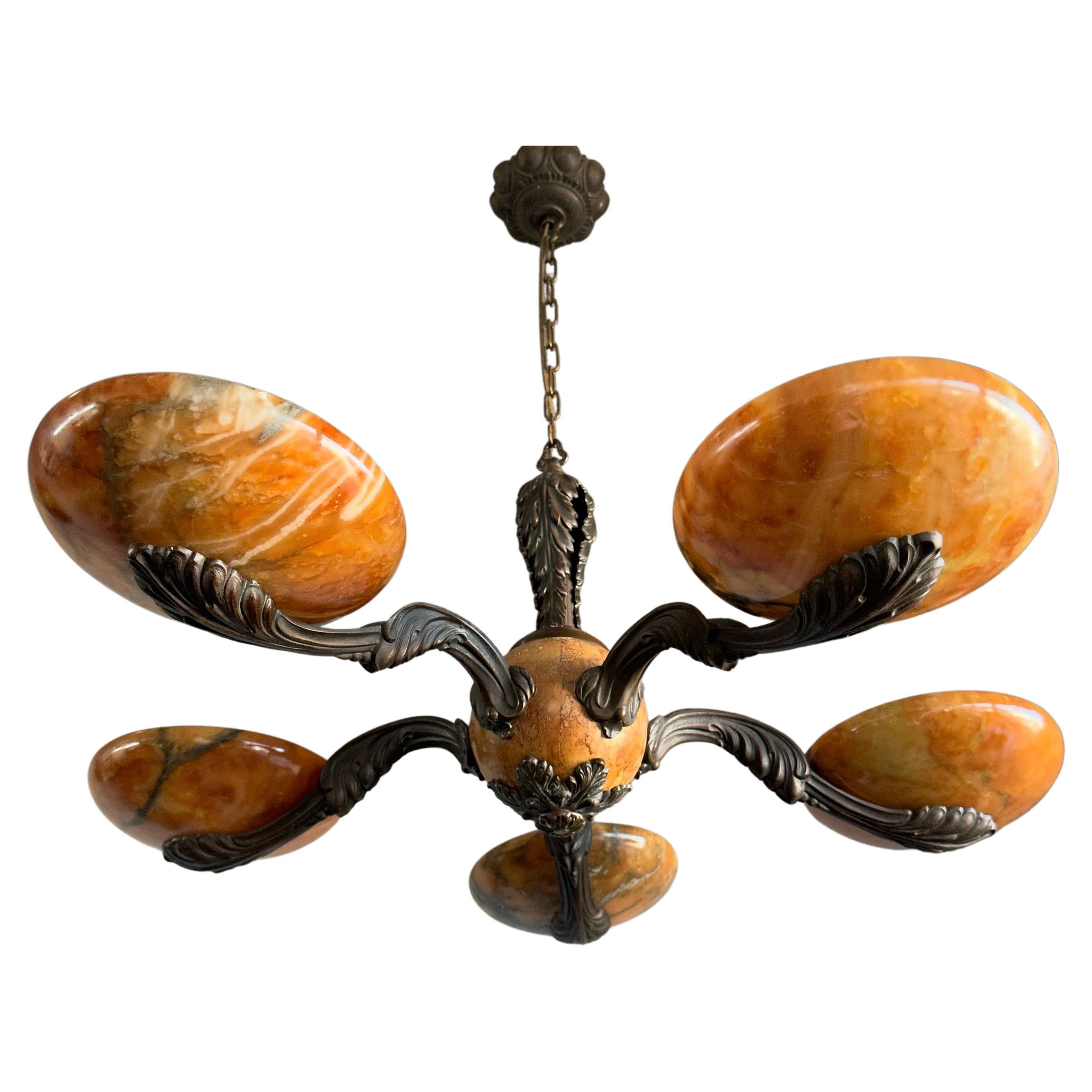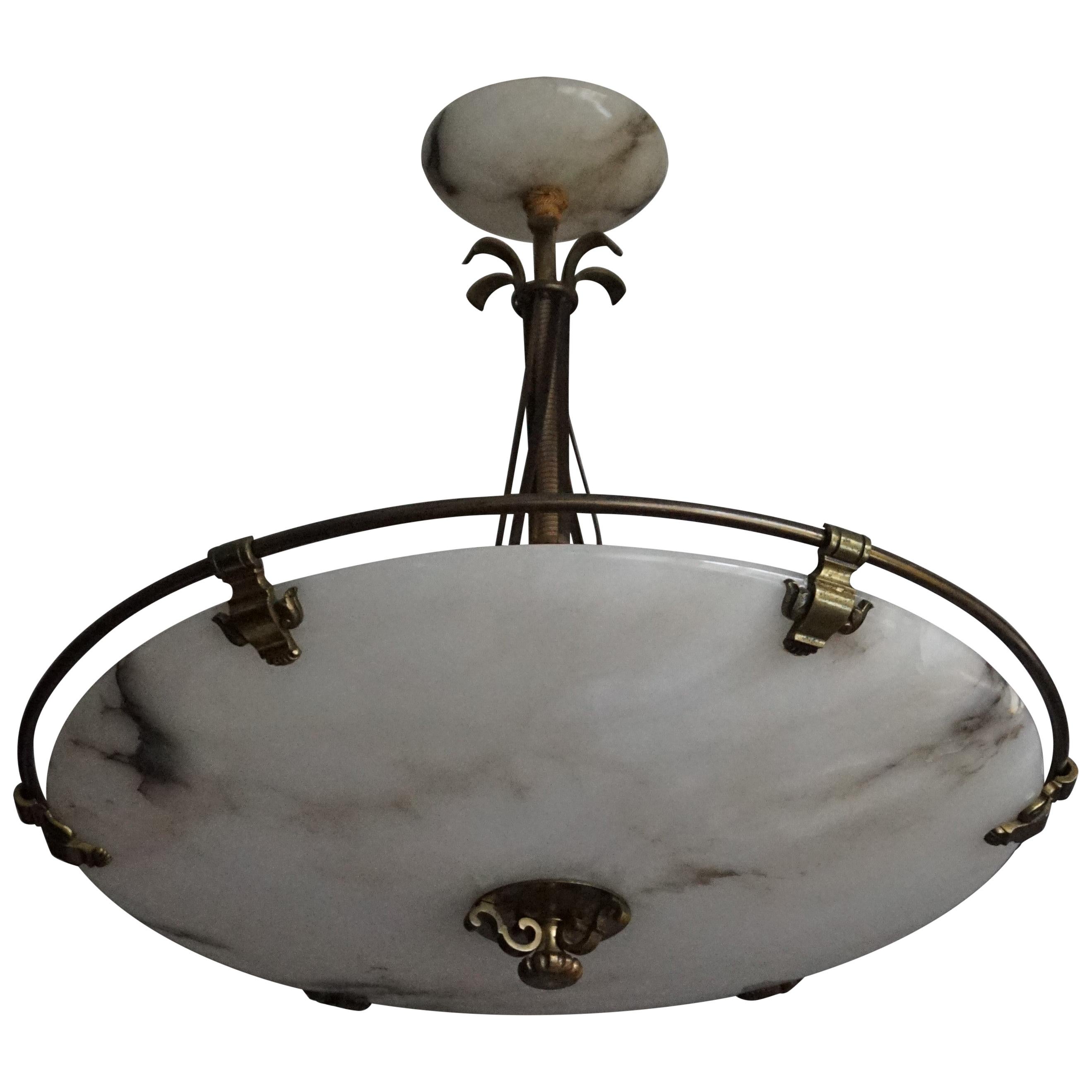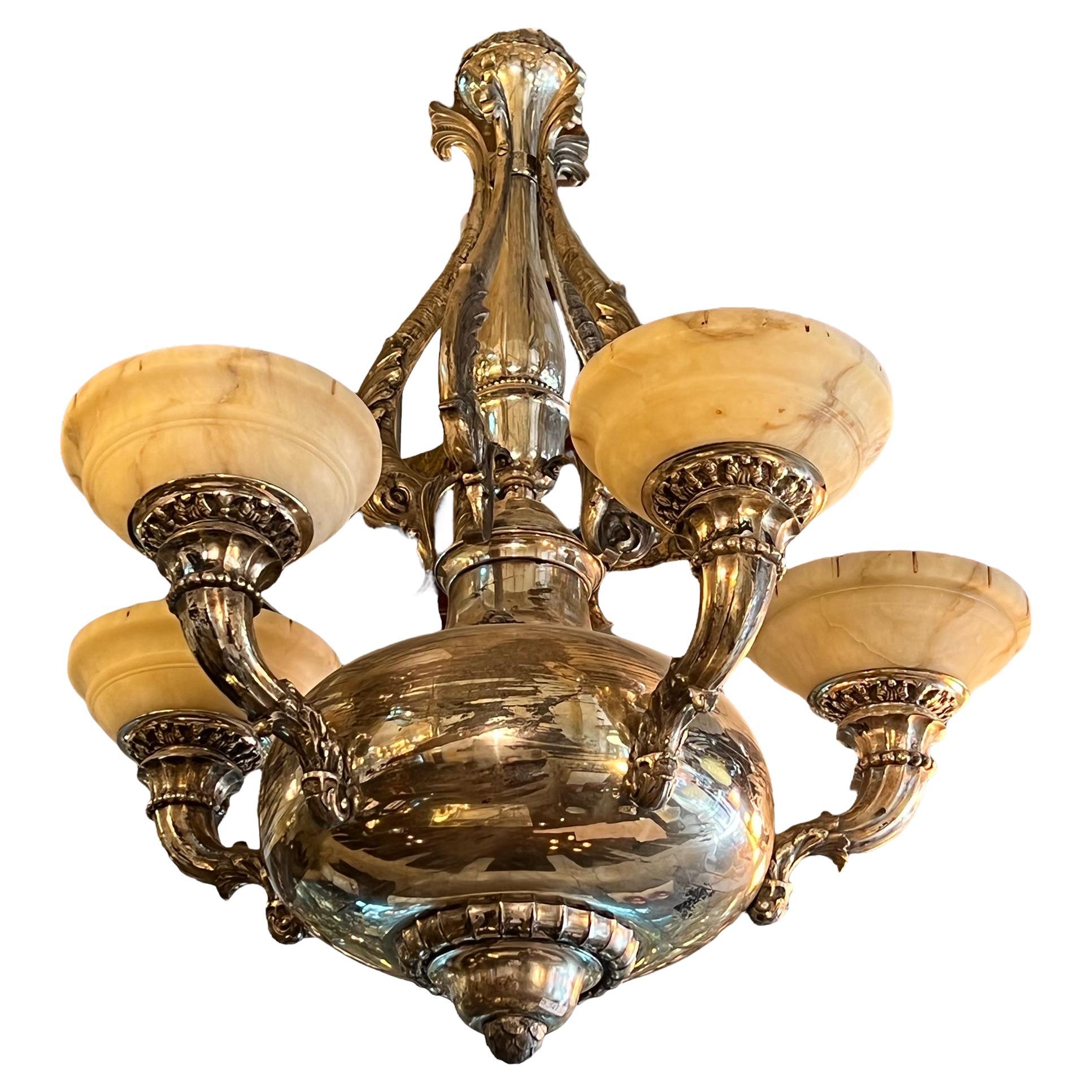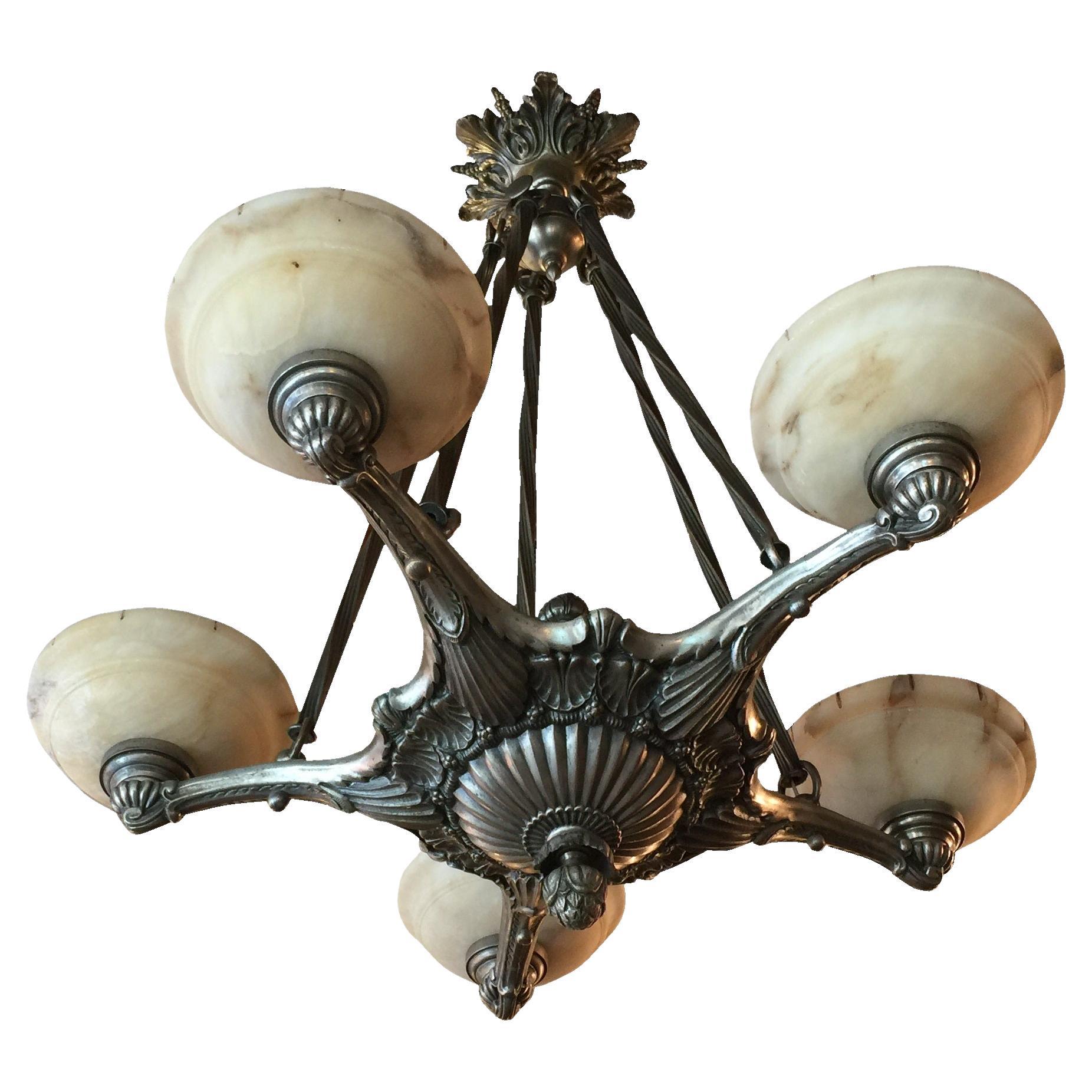Items Similar to Monumental Chandelier in Alabaster and silver plated bronze, Arts and Crafts
Video Loading
Want more images or videos?
Request additional images or videos from the seller
1 of 8
Monumental Chandelier in Alabaster and silver plated bronze, Arts and Crafts
About the Item
Luxury hanging lamp in Alabaster (alabaster light)
Year: 1880
Material: Alabaster , silver plated bronze
To take care of your property and the lives of our customers, the new wiring has been done.
We have specialized in the sale of Art Deco and Art Nouveau and Vintage styles since 1982. If you have any questions we are at your disposal.
Pushing the button that reads 'View All From Seller'. And you can see more objects to the style for sale.
Style: Arts and Crafts
The Arts and Crats movement emerged in the last decades from twentieth century, like a reaction againts the first industrial style that was developed in England. The one called Victorian Style. It is said that those who came to visit the Universal Fair in 1851, arrived to the Crystal Palace from London, and also amazed by the technical advances, were surprised by the bad taste of all that was massive manufacture. So the idea of industrial progress began to mingle with the intuition that a reaction was needed to return the objects of daily life a certain aesthetic dimension, to accompany thenatural functions for which they were manufactured. This reaction was named Art and Crafts, because it pretend to raise social dignity and aesthetics of design and applied arts of all, integrating them into a harmonious and beautiful architectural environment. From the action of Art & Crafts point of view, it experienced a major boost in 1861, when William Morris founded the firm Morris, Marshall, Faulkner Company, commonly known as the Morris Company. In 1890 Morris founded the Kelmscott Press, an imprint of the artisan who left small print runs of some of the most carefully printed books produced in history and was able to exert a powerful influence on the large commercial publishers for decades. Principles of Arts & Crafts Among the ideas of the Arts and Crafts features are philosophical, ethical and political. We highlight the most important: Rejection of the separation between art and craft. The design of useful objects is considered a functional and morality necessity. Refusal of industrial work, which separate the worker from the work done, fragmented tasks. Proposal for a return to medievalism, both in architecture (in Gothic) and the applied arts. Proposal of architecture as a center of all design activities. One idea would be collected by the rationalism of the early twentieth century. Proposed group of artisans in guilds and workshops, following the medieval model of collective work. Proposal of a job well done, well finished and satisfying to the artist and the customer.
If you have any questions we are at your disposal.
If you are looking for sconces to match your ceiling lighting, we have what you need.
Pushing the button that reads 'View All From Seller'. And you can see more objects to the style for sale.
Why are there so many antiques in Argentina?
In the 1880 – 1940 there was a grate wave of immigration encouraged by the periods of war that were taking place.
1st World War took place between 1914 and 1918
2nd World War took place between 1939 and 1945
The immigrants options were New York or Buenos Aires. Tickets were cheap and in Buenos Aires they were welcomed with open arms, as it was a country where everything was still to be done.
Argentina was the country of new opportunities, labour was needed and religious freedom was assured, in many cases the of the family travel first until they were settled and then the rest of the family members join them.
In the immigrant museum “Ellis Island Immigrant Building” in New York you can se the promotional posters of the boats that would take them to a new life.
Between the years 1895 and 1896, Argentina had the highest DGP (gross domestic product) per capita in the world according to the Maddison Historical Statistics index, this situation arose due to the large amount of food being exported to European countries, which were at war.
The Argentinean ships left the port of Buenos Aires with food, but they returned with furniture, clothes and construction elements, (it´s common to see this the old buildings of the historic neighbourhood of San Telmo, the beams with the inscription “Made in England)”, as well as many markets that were built in Buenos Aires, such us the San Telmo Market, whose structure was brought by ship and afterwards assembled in 900 Defensa Street.
With the great influence of European immigrants living in the country, the children of the upper classes travelled to study in France, resulting in the inauguration of “La Maison Argentinienne”, on 27th of June 1928, in the international city of Paris, which hosted many Argentinians that were studying in Frace.
It´s the fourth house to be built after France, Canada and Belgium, being the first Spanish-speaking one. Still in place today (17 Bd Jourdan, 75014, Paris, France). Many of the children of these wealthy families who attended international art exhibitions, museums and art courses abroad, took a keen interest in the European style. This is why Buenos Aires was at the time referred as “The Paris of South America”.
Between the years 1890 and 1920 more than a hundred Palaces were built on Alvear Avenue the most exclusive avenue in Buenos Aires. Today some of these palaces have been transformed into museums, hotels and embassies.
In the year 1936, the Kavanagh building was inaugurated, it was the tallest reinforced concrete building in South America.
During 1994 the American Society of Civil Engineers distinguished it as an “international engineering milestone”, and it´s now considered a World Heritage of Modern Architecture.
At the time was common to hire foreign architects such as Le Corbusier, who visited Buenos Aires/Argentina in 1929 and in 1948 he drew up the blueprints for a house built in La Plata City (which was declared a World Heritage Site).
In 1947, the Hungarian architect Marcelo Breuer designed “Parador Ariston” in the seaside city of Mar del Plata. After an Argentinean student at Harvard University convinced him to come to Argentina. He worked on an urban development project in the Casa Amarilla, area of La Boca.
The Ukrainian architect, Vladimiro Acosta, arrives in Argentina in 1928 and worked as an architect until que moved to Brazil.
Antonio Bonet, a Spanish architect who worked with Le Corbusier in Paris, arrives in Argentina in 1937, where he carried out several architectural works and in 1938 designs the well-known BFK chair.
Andres Kálnay, of Hungarian origin, made around 120 architectural masterpieces, among which the former Munich brewery stands out, he even made the furniture’s design.
The German architect, Walter Gropius, director of the Bauhaus, lived in Argentina, where he wrote articles for “Sur” magazine and founded in Buenos Aires, an architectural firm with Franz Möller, who was also an architect, where he built two houses.
At the same time several famous designers decided to immigrate to Argentina, among them we can find the well-known French designer, Jean-Michel Frank, who arrived in the country in 1940 and also worked for the Rockefeller family.
Special pieces were made, which were sold exclusively in the country, such as the well-known German company “WMF”, who sold their products by catalogue, which were chosen by the ladies of high society in the list of wedding gifts, as well as the pieces designed by Christofle.
The Swiss sculptor Alberto Giacometti, made special pieces for Argentinean mansions.
In 1904 the first Jansen branch outside Paris was established in Buenos Aires, as the Argentinean clientele demanded a large amount of furniture, from the end of the 19th century to the mid-20th century.
In 1970, the brand Rigolleau Argentina made pieces authorised by Lalique.
The brands Maple and Thompson also set up shop in the country.
The French plastic artist, Marcel Duchamp moved to Argentina in 1918-1919.
Glass signed Gallé, Charder, Leverre, Schneider, Muller and other French firms. They were bought in flower shops and were given to ladies with beautiful floral arrangements.
Some furniture manufacturers travelled to international fairs and bough the patterns to produce the furniture in Argentina, such as the furniture firm Englander and Bonta, who bought the patterns ins Italy.
It is worth mentioning that in Argentina we have the largest community of Italians outside of Italy, as it is estimated that 70 percent of the inhabitants have at least one Italian descendant, followed by Spanish immigrants.
The most Important furniture stores in Argentina:
Comte is founded in 1934 (under the direct management of Jean Michel Frank in 1940).
Nordiska (Swedish company established in 1934).
Churba in 1960, a company that brought foreign designers to present their furniture in the country:
Denmark: (Arne Jacobsen, Finn Juhl, Bender Madsen, Ejner Larsen, Poul Kjaerholm, Hans Wegner)
Sweden: (Hans Agne Jakobsson, Gustavsberg)
United States: (Herman Miller)
Finland: (Lisa Johansson, Folke Arstrom, Tapio Wirkkala, Alvar Aalto, Timo Sarpaneva)
Swedish Factory: (Orrefors)
Italy: (Littala, Vico Magistretti, Emma Gismondi, Gae Aulenti, Angelo Mangiarotti, Elio Martinelli, Gianna Celada, Angelo Mangiarotti, Mario Bellini, Carlo Scarpa)
Finland: (Olivia Toikka)
Plata Lappas (Lappas Silver): a goldsmith shop founded in 1887 in Argentina by Alcibiades Lappas of Greek origin.
In 2019, in Argentina took place “the Art Deco world congress”, in which we participated as hosts invited by Geo Darder, founder of the Copperbridge – Foundation, in which prominent people from all over the world attended to learn about Art Deco in Argentina.
Argentina currently has more than 100 Art Deco buildings and another 90 Art Nouveau buildings throughout the city of Buenos Aires.
Argentina is a country that has not been involved in many wars, which is why it has been a refuge for works of art and antiques from different periods of time, unlike European countries. That is way many collectors, museums and antique dealers from all over the world visit it, you should not miss the opportunity to visit this great country.
Laura Guevara Kjuder, architect.
- Dimensions:Height: 57.09 in (145 cm)Diameter: 31.5 in (80 cm)
- Power Source:Hardwired
- Voltage:220-240v
- Lampshade:Included
- Style:Arts and Crafts (Of the Period)
- Materials and Techniques:
- Place of Origin:
- Period:
- Date of Manufacture:1880
- Condition:Rewired: To take care of your property and the lives of our customers, the new wiring has been done. Wear consistent with age and use.
- Seller Location:Ciudad Autónoma Buenos Aires, AR
- Reference Number:
About the Seller
5.0
Vetted Seller
These experienced sellers undergo a comprehensive evaluation by our team of in-house experts.
Established in 1982
1stDibs seller since 2022
21 sales on 1stDibs
Typical response time: <1 hour
- ShippingRetrieving quote...Ships From: Ciudad Autónoma Buenos Aires, Argentina
- Return PolicyThis item cannot be returned.
More From This SellerView All
- Art Deco 1930 Chandelier in Silver Plated Bronze and AlabasterLocated in Ciudad Autónoma Buenos Aires, CStyle: Art Deco Year: 1930 Material: silver plated bronze and alabaster For your safety and that of your property, all our lighting have new electric cables. We always think of our c...Category
Vintage 1930s French Art Deco Chandeliers and Pendants
MaterialsAlabaster, Bronze
- Art Deco 1930 Chandelier in Silver Plated Bronze and AlabasterLocated in Ciudad Autónoma Buenos Aires, CStyle: Art Deco Year: 1930 Material: silver plated bronze and alabaster For your safety and that of your property, all our lighting have new electric cables. We always think of our c...Category
Vintage 1930s French Art Deco Chandeliers and Pendants
MaterialsAlabaster, Bronze
- Chandelier Viennese Secession, 1900, Silver Plated Bronze and AlabasterLocated in Ciudad Autónoma Buenos Aires, CHanging lamp Vienna Secession Material: silver plated bronze and alabaster Style: Vienna Secession Country: Vienna If you are looking for sconces to match your ceiling lighting, we ...Category
Antique Early 1900s Austrian Vienna Secession Chandeliers and Pendants
MaterialsAlabaster
- Chandelier in Alabaster and Silver Plated Bronze, Style: Art Deco, Year: 1920Located in Ciudad Autónoma Buenos Aires, CChandelier in alabaster. Style: Art Deco Year: 1920 Materials: Alabaster and silver plated bronze To take care of your property and the lives of our customers, the new wiring has be...Category
Vintage 1920s French Art Deco Chandeliers and Pendants
MaterialsAlabaster
- Monumental Chandelier Art Nouveau in silver plated bronze, Tulips sign SchneiderBy Charles SchneiderLocated in Ciudad Autónoma Buenos Aires, CAmazing Hanging Lamps in Silverplater Style: Art Nouveau and Modernism or Jugendstil Year: 1915 Material: silver plated bronze, Glass Schneider Tulips sign Schneider If you are look...Category
Vintage 1910s French Art Nouveau Chandeliers and Pendants
MaterialsBronze, Silver Plate
- Chandelier in Silver Plated Bronze and Plastic, 50°, ItalianLocated in Ciudad Autónoma Buenos Aires, CHanging lamp. Materials: in Silver plated bronze and plastic. Style: 50 Country:: italy To take care of your property and the lives of our customers, the new wiring has been done. W...Category
Vintage 1950s Italian Space Age Chandeliers and Pendants
MaterialsBronze
You May Also Like
- Rare and Stylish Bronze & Alabaster Arts and Crafts Chandelier / Light FixtureLocated in Lisse, NLUnique, elegant and well balanced pendant light. If you are looking for an antique and classy light fixture to grace your living space then this stunning light from the European Art...Category
Early 20th Century European Arts and Crafts Chandeliers and Pendants
MaterialsAlabaster, Metal, Bronze
- Stunning and Large Alabaster, Brass and Bronze Chandelier Arts & Crafts EraLocated in Lisse, NLTimeless and highly stylish antique, three light pendant. This incredibly stylish antique fixture is one of the best alabaster lights we have ever had the pleasure of offering. This...Category
Early 20th Century European Arts and Crafts Chandeliers and Pendants
MaterialsAlabaster, Bronze, Brass
- Arts & Crafts Wrought Iron & Bronze ChandelierLocated in New York, NYAntique hand hammered bronze and iron eight light chandelier. Cleaned and restored. Takes eight medium base light bulbs. Please note, this item is located in our Scranton, PA location.Category
Early 20th Century American Arts and Crafts Chandeliers and Pendants
MaterialsBronze, Wrought Iron
- Large arts and crafts style patinated bronze chandelierLocated in New York, NYThis fabulous chandelier must be seen in person to be truly appreciated. The generous proportions of the heavily stylized acanthus leaf arms seems imposing at first, but is balanced ...Category
Late 20th Century French Arts and Crafts Chandeliers and Pendants
MaterialsBronze
- Large Arts and Crafts Alabaster & Wrought Iron Chandelier with Apple SculpturesLocated in Lisse, NLOne of a kind and truly amazing Arts & Crafts pendant. Over the years we have owned and sold a number of unique alabster light fixtures from the Arts & Crafts era, but never did we ...Category
Early 20th Century European Arts and Crafts Chandeliers and Pendants
MaterialsAlabaster, Wrought Iron
- Antique Chandelier Arts and CraftsLocated in Oxfordshire, GBArts & Crafts brass chandelier. Edwardian Arts & Crafts elaborate brass six branch electrolier ceiling light. The Chandelier compromising of a large 66 cm brass band with six hanging light fittings, the fittings with the six original glass shades. The light with brass ceiling rose with hook, three ornamental brass bars hang from this and attach to a brass band. Six more...Category
Antique Early 1900s British Arts and Crafts Chandeliers and Pendants
MaterialsBrass
Recently Viewed
View AllMore Ways To Browse
Arts And Crafts Office
Arts And Crafts Entry
Arts And Crafts Hall
Arts And Crafts Hall Furniture
Arts And Crafts Entry Hall Furniture
Arts Crafts Signed
All Arts And Crafts
French Arts And Crafts
Country Arts And Craft
Arts And Crafts Floral
Arts And Crafts Flower
Antique Looking Plates
Spanish Arts And Crafts
Antique Collector Plates
Vintage And Antique Lighting
Antique And Vintage Lighting
Antique Arts And Crafts Lighting
Arts And Crafts Lighting Antique





